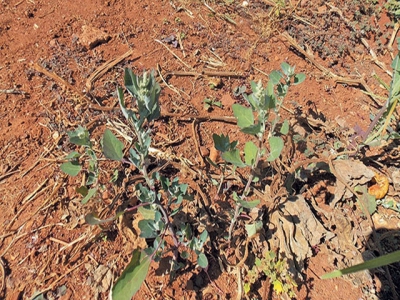Get to know how your crop thinks

A crop has no way of ‘knowing’ or ‘sensing’ your good intentions. Instead, it responds to the prevailing conditions as a means of self-preservation.
Plants adapt to conditions. Under stress, these Chenopodium plants produced smaller leaves. They can easily grow to 2m in good conditions. Photo: Bill Kerr
If you intervene too late to correct a problem, the plant would already have made other provisions to help it survive, but with a reduced yield.
Plants in the wild are in fierce competition with one another and face numerous hazards: bad weather, infertile soil, hungry pests and more. It all comes down to survival of the fittest, and the ability of a species to survive and reproduce is stamped into its genetic make-up.
Many ‘survival genes’ from wild, ancestral forms are present in modern domesticated crop plants. Understand this and you will be able to manage a crop in a way that will maximise production.
The first step is to remember that once the seed is in the ground, the plant immediately ‘plans’ how it will respond to prevailing conditions.
If something is lacking, the plant switches to ‘survival mode’; the plant will thus survive, but with restricted growth.
Producing a large frame will require more inputs such as water and fertiliser. These might not be forthcoming and the plant could die without having produced seed to ensure the next generation.
A smaller frame is more likely to ensure survival, at least until it can produce those all-important seeds.
You can apply this knowledge in practice by ensuring that the crop has all it needs to thrive from the start. For example, if you wait too long before applying nitrogen to cabbage, the crop will adapt to the prevailing ‘lack’ by producing a smaller frame.
It is, of course, unaware that you are going to rectify the situation next Wednesday!
At the same time, because conditions vary from day to day, plants have evolved so that they do not switch to survival mode too hastily.
Being aware of this can act in your favour; when you see a plant showing symptoms of deficiency, whether water, nutrients or anything else, you have only a little time before the plant responds in a way that affects your expected yield.
During the recent rainy period, many farmers found that nitrogen was leaching out of the soil.
I came across many crops showing severe nitrogen deficiency. However, farmers with a good understanding of how plants ‘think’ had applied nitrogen long before signs of nitrogen deficiency became visible.
These farmers were aware of what would happen and applied nitrogen as soon as possible. Some even applied it several times over the rainy period.
Reducing risks
To sum up, once a crop shows you that something is preventing optimal growth, it is highly likely there has already been a loss of potential yield. Understanding a crop and the conditions that influence its behaviour and growth can reduce some of the risks.
Có thể bạn quan tâm
 Vietnam’s rice exports up in both volume and value in first eight months
Vietnam’s rice exports up in both volume and value in first eight months Vietnam exported 4.53 million tonnes of rice in the first eight months of 2018, bringing in US$2.29 billion, a rise of 10.5% in volume and 26.5% in value
 Citrus fruits yield over 50,000 tonnes in Luc Ngan district
Citrus fruits yield over 50,000 tonnes in Luc Ngan district Thanks to the intensive technique application, the locals are expecting for a bumper crop this year with an estimated output of over 50,000 tonnes
 Fruits and veggies join Vietnam's export staples
Fruits and veggies join Vietnam's export staples With a growth rate of 14% year-on-year, it is estimated that exports of vegetables and fruits could reach US$4 billion by the end of 2018, Tien Phong newspaper